Understanding Cannabis Seed Categories: Key Types
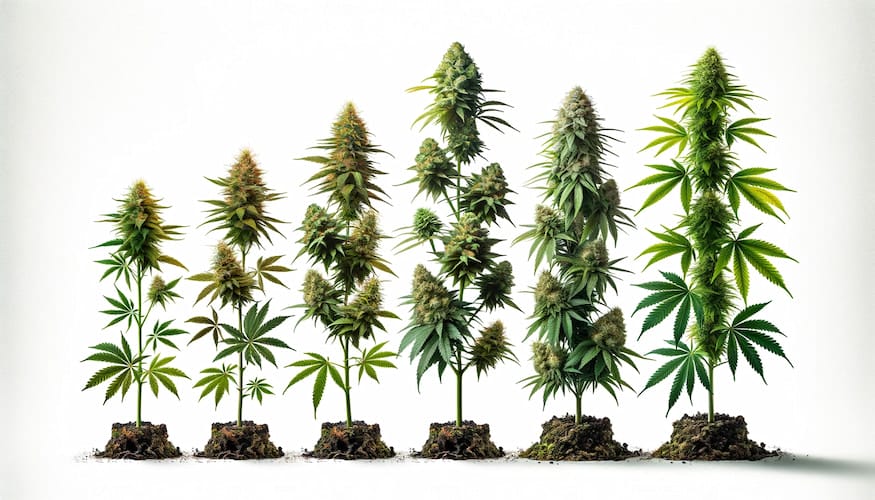
Imagine nurturing a plant for months only to realize it’s not what you expected. This is the plight many face without proper knowledge about the seed categories of cannabis. Choosing among the different types of cannabis seeds isn’t just a matter of preference; it’s a strategic decision that defines the journey from seed to harvest. Whether you’re a seasoned grower or a green-thumbed novice, understanding the intricacies of cannabis seed types can make or break your efforts to cultivate that quintessential, high-quality yield.
From selecting the best cannabis seeds in your cannabis seed collection to making an informed cannabis seed selection, every step is crucial. Regular, feminized, or autoflower—which type truly aligns with your cultivation goals? These cannabis seed categories hold the blueprint for the growth, potency, and productivity of your plants. It’s time to delve deep and equip yourself with the knowledge that will elevate your experience from haphazard guessing to masterful cultivation!
Key Takeaways
- Identify key differences between regular, feminized, and autoflower cannabis seeds
- Adjust your cultivation strategy based on the chosen seed category of cannabis
- Maximize your harvest potential by carefully integrating cannabis seed types into your growth plans
- Uncover which cannabis seed categories are ideal for personal enjoyment, medicinal use, or breeding purposes
- Establish the importance of high-quality cannabis seeds in achieving a successful cannabis cultivation endeavor
- Comprehend how the cannabis seed collection you acquire impacts the overall outcome of your garden
- Explore the benefits of informed cannabis seed selection and how it can streamline your cultivation experience
An Introduction to Cannabis Seed Categories
The diverse world of cannabis seed genetics offers a variety of types, each born from specific breeding techniques suited to different growing conditions and cultivation preferences. Whether you are a novice to the world of cannabis cultivation or a seasoned grower, you will encounter seed varieties of cannabis that cater to different needs and goals. These range from regular seeds, which are the natural result of male and female plant pollination, to the predictably female-producing feminized seeds, and the time-efficient autoflower seeds.
Defining Regular, Feminized, and Autoflower Seeds
Understanding the characteristics of each type of cannabis seeds is essential for optimizing your growing experience. Regular seeds are the most natural form, typically offering a 50/50 chance of producing male or female plants. They are crucial for breeders looking to create new strains or growers aiming for a more traditional approach. On the other hand, feminized seeds are designed to generate only female plants, the ones that produce the valuable buds, therefore eliminating the need to identify and remove male plants during cultivation. Lastly, autoflower seeds merge the resilience and fast-flowering genetics of Cannabis Ruderalis with classic strains, enabling the plant to flower based on age, independent of light cycles.
The Role of Genetics in Cannabis Seed Varieties
Cannabis genetics play a crucial role in the development of these distinct seed varieties of cannabis. Breeders carefully select parent strains to produce seeds with desirable traits such as high THC levels, robust growth patterns, or specific flavor profiles. Seed genetics influence everything from the ease of growing to the effects of the final product, making it a fundamental consideration for both cultivators and consumers alike.
| Type of Seed | Genetic Composition | Flowering Trigger | Grower Considerations |
|---|---|---|---|
| Regular Seeds | Genetic mix from male and female plants | Light cycle dependent | Identification of plant sex required |
| Feminized Seeds | All female-producing genetics | Light cycle dependent | No need to identify plant sex |
| Autoflower Seeds | Combines Ruderalis with other strains | Age dependent, not light cycle | Suitable for quick turnaround |
By understanding the intricacies of regular, feminized, and autoflower seeds, cultivators can more effectively plan their crops and expect better outcomes. From the casual home grower to the commercial agriculture venture, recognizing the right types of cannabis seeds is a key step in shaping a cultivation strategy that yields desired results, whether concerning potency, flavor, or harvest size.
Regular Cannabis Seeds Explained
Within the diverse world of cannabis cultivation, regular cannabis seeds are often seen as the traditional cornerstone. Unlike their genetically modified counterparts, these seeds are the product of unaltered natural pollination, offering the purest form of cannabis genes available to cultivators.
The Basics of Regular Seeds
Regular seeds are born from the natural mating of male and female cannabis plants. These parent plants pass on their genetics to create seeds that have the potential to grow into either male or female plants. Despite the modern trend towards specialized seeds such as feminized and autoflower varieties, regular seeds remain a staple for breeders and purists seeking to maintain genetic diversity.
Advantages and Challenges of Growing Regular Seeds
Choosing to grow regular seeds comes with its unique set of advantages and challenges. For growers interested in breeding and developing new strains, the regular seeds are unrivaled as they facilitate the mixing of different genetic traits.
Growing regular cannabis seeds offers the thrill of genetic exploration, a journey embracing the full spectrum of cannabis’s diverse characteristics.
However, the cultivation of regular seeds necessitates a level of vigilance and decision-making. Growers must carefully monitor their plants during the flowering stage to identify and separate male from female plants to prevent pollination, unless seed production is the goal.
- Genetic Diversity: One of the principal benefits of using regular cannabis seeds is the genetic diversity it ensures. This is crucial for breeders who seek to enhance strain characteristics through selective breeding.
- Cultivation Costs: Without the need for genetic manipulation, regular seeds can often be less expensive than their feminized or autoflower counterparts. This makes them an economical choice, particularly for those just starting out in cannabis cultivation.
- Challenges: The requirement to identify and remove male plants to prevent undesired pollination adds an additional layer of labor and complexity to the cultivation process.
Indeed, regular seeds offer a myriad of cultivation opportunities. From the joy of discovery in breeding to the challenges of precise plant management, these seeds serve as a crucial element in understanding the fundamental cannabis seed characteristics. As the cannabis industry continues to evolve, the role of regular versus feminized cannabis seeds and regular feminized autoflower seeds will remain a topic of keen interest for many in the community.
Decoding the Feminized Cannabis Seeds Phenomenon
The cultivation landscape has been significantly transformed with the advent of feminized cannabis seeds. This innovation in plant breeding has altered not only the cultivation processes but also the efficiency of cannabis production, favoring the yield of high-quality, resinous buds.
The Science Behind Feminization of Cannabis Seeds
Feminized seeds are the product of precise genetic manipulation. They have been a game-changer, especially for those choosing the right cannabis seeds for their operations. Through either the application of colloidal silver or strategic light adjustments, female cannabis plants can produce male flowers. These male flowers still contain the female plant’s genetics and, when used to pollinate other female plants, ensure a lineage of seedlings that are almost exclusively female.
The process eliminates essentially all male chromosomes, which is why when you plant feminized cannabis seeds, male plants are a rarity. This genetic certainty is crucial for cultivators who seek to maximize their yield without the need for segregating and removing male plants during the flowering phase.
Why Feminized Seeds are Popular Among Growers
Feminized seeds have rapidly gained traction in cannabis cultivation circles because of the direct benefits they offer. By eliminating the need for sex identification of plants, growers can allocate their resources and space more efficiently, dedicating their full attention to nurturing the high-producing female plants. The benefits of autoflower cannabis seeds also come into play for those looking for even faster cultivation cycles, although they have their distinct set of characteristics.
Below is a comparison table between traditionally grown feminized seeds and their autoflower counterparts, outlining their primary benefits and why they have become favorites among cannabis cultivators:
| Feminized Cannabis Seeds | Autoflower Cannabis Seeds |
|---|---|
| Higher assurance of all-female plants | Independence from light cycles to flower |
| Maximized space usage and efficiency | Shorter growth to harvest time |
| Increased resin production for potent harvests | Ability to achieve multiple harvests in a season |
| Ideal for controlled indoor environments | Compact plant size suitable for small spaces |
The consistent rise in popularity of feminized seeds is a testament to their profound impact on cannabis cultivation. Whether for personal use or commercial scale operations, the benefits of feminized seeds coupled with the ease of cultivation make them an excellent choice for many. As the industry continues to evolve, it’s certain that the quest for efficient, high-yield, and quality harvests will keep feminized cannabis seeds at the forefront of growers’ preferences.
The Rise of Autoflowering Cannabis Seeds
The horticultural landscape is continuously evolving, and the influx of autoflowering cannabis seeds underscores a revolutionary shift in cannabis cultivation methods. These seeds are derived from the hardy lineage of Cannabis Ruderalis, known for their remarkable resilience and the ability to flower independently of light schedules. In this section, we dive into the genetic makeup of these innovative seeds and explore the array of advantages they offer to both novice gardeners and large-scale cultivators.
Understanding Autoflower Cannabis Genetics
A quintessential trait of autoflower seeds is their predetermination to flower after a certain period, the knowledge of which is critical in understanding autoflower cannabis seeds. The genetic heritage stemming from regions with limited sunlight has ingrained an automatic switch to begin blooming, usually within two to four weeks of germination. This genetic programming is a game-changer in the cannabis industry, enabling a more streamlined and predictable growing process.
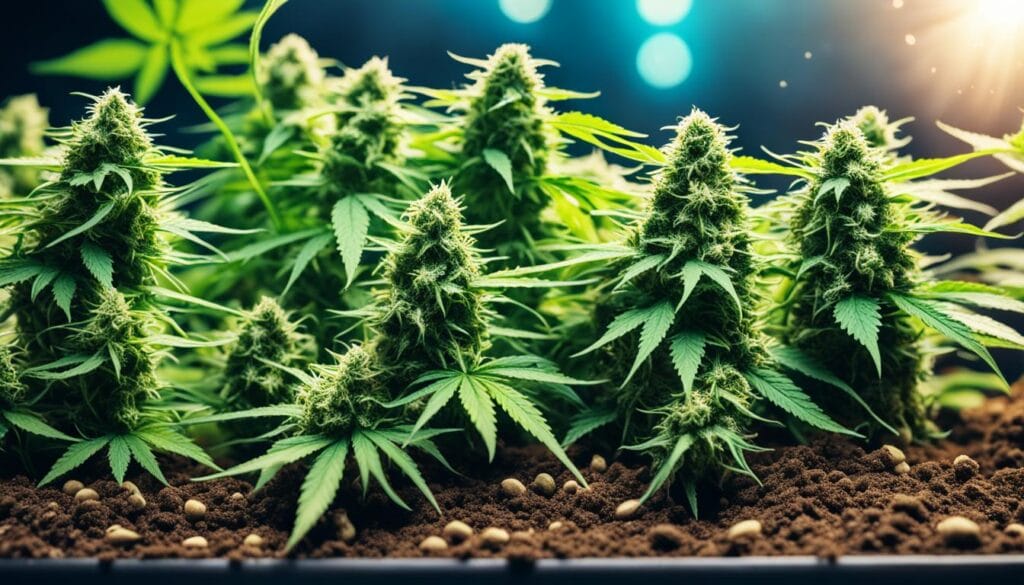
Benefits of Autoflower Seeds for Beginners and Commercial Growers
The benefits of autoflower cannabis seeds are manifold, especially when considering the varied needs of individuals and commercial enterprises. Here’s an overview that encapsulates the essence of what these agile seeds have to offer:
- Simplified Cultivation: For newcomers to cannabis growing, autoflowers present an ideal starting point due to their undemanding nature, resilience to climate fluctuations, and eradication of stringent light cycle management.
- Rapid Turnaround: As autoflowers complete their lifecycle swiftly, growers can achieve more harvests annually—an attractive prospect for those looking to maximize yields in minimal time.
- Space Efficiency: Compact and bushy, autoflowering plants are conducive to small indoor spaces, or for maximized use of larger commercial grow facilities—a vital consideration for optimizing revenue and operation costs.
- Versatility: The hardwearing genetics provide for cultivation in a wider range of environments, inviting growers from less-than-ideal climates to engage in cannabis agriculture with confidence.
Autoflower cannabis seeds have significantly affected cultivation strategies, prompting an inclusive approach that appeals to a broader audience. Their rise within the cannabis cultivation community is a testament to their adaptive nature and the diverse benefits they unlock for growers at all levels of expertise.
Differentiating Between Cannabis Indica and Sativa Seeds
When diving into the world of cannabis cultivation, understanding the differences between cannabis Indica and cannabis Sativa is crucial. Their unique characteristics have a profound impact on the experience for both growers and users. Indica seeds are famed for producing plants that bring about profound relaxation and are typically higher in CBD, which is desirable for those seeking a calming effect. Conversely, Sativa seeds give rise to strains known for their invigorating energy, making them the preferred choice for daytime use.
Adding to the complexity, Ruderalis, with its auto-flowering trait, often enters the mix in hybrid seeds, offering indifferent flowering patterns in response to light exposure. As the cannabis industry evolves, the focus is beginning to shift from simply indica vs sativa to a more precise identification based on chemical profiles, or chemovars.
A Closer Look at Indica and Sativa Strains
Laying out the differences in a tabular format does not only cater to visual appeal but serves to clearly contrast these two primary varieties, assisting enthusiasts and cultivators in making informed decisions:
| Cannabis Type | Typical Effects | Plant Characteristics | Common Usage |
|---|---|---|---|
| Indica | Relaxing, sedative | Dense, bushy plants with broad leaves | Nighttime use |
| Sativa | Energizing, uplifting | Tall plants, narrow leaves | Daytime use |
The debate of sativa vs indica is about more than just personal preference. Each type brings to the table distinct growth patterns and medicinal potential, influencing decisions in cultivation and consumption. In recent developments, breeders have also been incorporating genes from Ruderalis to create hybrids that defy traditional classifications and bloom independently of light changes.
As we progress, the cannabis community recognizes the value in understanding not just whether a plant is Indica or Sativa, but also in its overall cannabinoid and terpenoid profiles, which offer a more granular appellation of its potential effects and therapeutic benefits.
To stay at the forefront of this evolving industry, considering indica vs sativa is merely the first step. Cultivators and consumers must both embrace the spectrum of genetic diversity available, including the resilient characteristics of Ruderalis, to truly appreciate the intricacies of the cannabis plant.
Autoflower vs Regular Cannabis Seeds
For cultivators and enthusiasts making pivotal decisions about their cannabis gardens, understanding the key pros and cons between autoflower vs regular cannabis seeds is indispensable. This comparison transcends mere preference, anchoring on the differences between cannabis seed categories which dramatically affect the cultivation process and end results.
Regular seeds, the traditional option in cannabis agriculture, are cherished for their natural qualities and versatility. They are known for their role in cultivating new strains and preservation of the genetic lineage, which is paramount in the ongoing development of diverse and robust cannabis varieties. Yet, their dependency on light cycles for flowering and the requirement of identifying and removing male plants pose a considerable challenge, especially for inexperienced growers.
On the flip side, autoflower seeds offer simplicity and efficiency. They embody the pinnacle of ease with their ability to flower without the need for strict light schedules, making them ideal for beginners or those with limited space who seek a fast-track harvest. Despite their convenience, some perceive their smaller stature and potentially lighter yields as drawbacks when benchmarked against the abundant harvests oft-associated with regular seeds.
Pros and Cons of Autoflower and Regular Cannabis Seeds
| Seed Type | Pros | Cons |
|---|---|---|
| Autoflower Seeds | Easy to grow, no light cycle management required, faster harvest turnaround | Generally smaller plants, lower yield |
| Regular Seeds | Genetic purity for breeding, larger potential yield | Requires sexing of plants, light cycle management for flowering |
In assessing regular vs feminized vs autoflower seeds, growers weigh their goals, resources, and commitment to the craft. Regular seeds may compel those keen on honing their horticultural skill and cultivating their strains, while autoflower strains may appeal to proponents of efficiency and simplicity in their cultivation journey.
Understanding one’s requirements and abilities is paramount in making an educated choice between autoflower and regular cannabis seeds, as this choice is intrinsically linked to the grower’s experience and the cultivation environment.
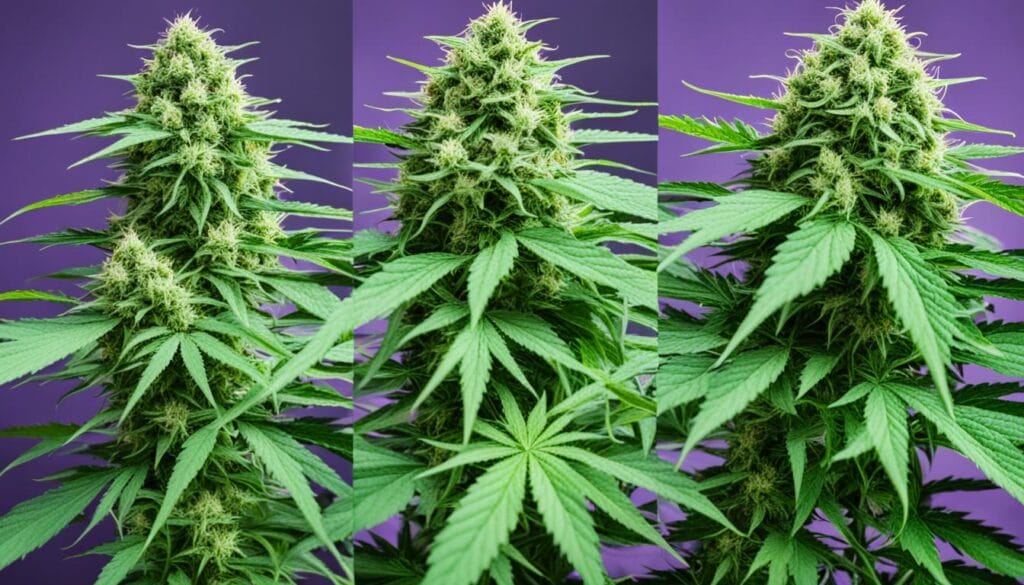
Ultimately, the debate of autoflower vs regular cannabis seeds is not one of superiority versus inferiority. Instead, it is a conversation about the best fit for individual scenarios and aspirations, echoing the diversity of preferences within the cannabis community. Savvy growers recognize the differences between cannabis seed categories are not merely technical but reflect the adaptiveness of the plant and the nuanced needs of those cultivating it.
Seed Categories of Cannabis: Regular, Feminized, and Autoflower
Understanding the different seed categories of cannabis is essential for growers seeking to tailor their cultivation to specific types of plants and desired outcomes. Regular feminized autoflower seeds represent the core classifications, each offering unique advantages for various growing scenarios.
Regular seeds are akin to a genetic lottery with equal chances of yielding male or female plants. Their unpredictable nature is sought after by breeders and traditionalists who are looking to propagate new strains or maintain genetic diversity. In contrast, feminized seeds are cultivated to produce solely female plants, ensuring every plant contributes to the harvest. This seed type is particularly popular among growers focused on yield maximization. Lastly, autoflower seeds are heralded for their quick growth cycle and the ability to flower without changes to the light cycle. This category appeals to those desiring a fast, low-maintenance crop.
To illustrate the differences between cannabis seed categories, let’s compare their key characteristics:
| Seed Type | Photoperiod Dependency | Typical Gender Ratio | Flowering Trigger | Suitable For |
|---|---|---|---|---|
| Regular | Yes | 50% Male / 50% Female | Light Cycle Change | Breeding, Genetic Diversity |
| Feminized | Yes | 99% Female | Light Cycle Change | Maximizing Yield |
| Autoflower | No | Mostly Female | Age | Time-sensitive & Low Maintenance Grows |
Each cannabis seed classification has been designed with certain cultivation ideals in mind. Regular vs feminized vs autoflower seeds offer a spectrum of options for growers to work within the confines of their environmental conditions, expertise level, and personal preferences.
Understanding the cannabis seed varieties and their traits can make the difference between a bountiful harvest and a disappointing yield. It’s not just about choosing a seed, but making an informed decision that aligns with one’s cultivation strategy and ambitions. Whether you’re a novice gardener or a seasoned grower, grasping the seed types in cannabis is a foundational step towards cultivating success.
Navigating the World of Seed Banks and Quality Assessment
As the quest for the best cannabis seeds intensifies, both connoisseurs and novices are turning their focus towards the world’s top-rated cannabis seed banks. A seed bank’s reputation stands as the bedrock of quality, and meticulous assessment is key to satisfying one’s stringent cannabis cultivation criteria. Unearthing the most high-quality cannabis seeds involves a balance of botanical knowledge, marketplace insight, and consumer savviness, ensuring one’s horticultural pursuits spring from the best possible foundation.
How To Identify High-Quality Cannabis Seeds
Discerning the quality of cannabis seeds is a sensory and informational pursuit. A physical examination can reveal signs of maturity and health, such as the seed’s firmness and a smooth, uncracked surface. The coloration should be a telltale mottled pattern of brown, tan, and even black, avoiding seeds that appear green or pale, which suggest immaturity. A seed’s buoyancy in water can also serve as a rudimentary test of viability, albeit not infallible. However, physical characteristics alone cannot unveil the genetic tapestry that dictates a seed’s potential—the linchpin lies in its provenance.
Tips for Buying Cannabis Seeds Online from Reputable Sources
Buying cannabis seeds online should be approached with diligence. Seek out established and best cannabis seed banks known for their commitment to genetics and customer satisfaction—places like SeedsHereNow.com offer transparency and depth in their offerings. Always inspect customer feedback, which can provide real-world insights into a strain’s performance and the seed bank’s service quality. Equally important is exploring germination guarantees—assurance that reflects a seed bank’s confidence in selling high-quality cannabis seeds. Consider discreet shipping options to ensure privacy and secure payment methods for financial safety. Making informed choices not only solidifies a seamless transaction but also secures peace of mind as you buy cannabis seeds online.
Comparing the Effects: Indica, Sativa, and Hybrid Seed Strains
When it comes to selecting cannabis seeds, the indica vs sativa discussion is central to understanding the potential experiences they offer. Indica seed strains are often sought after for their calming effects, commonly utilized in the evening to relax. Sativa seeds, by contrast, are known for producing a stimulating sensation, preferred during the day for an energy boost. Hybrid cannabis varieties combine traits from both ends of the spectrum, providing a balance that caters to unique user needs. Let’s dive a little deeper into how these seed strains differ in their chemical profiles and their associated influences on consumer experience.
Chemovars and the New Age of Cannabis Classification
The term chemovars, sometimes known as chemical varieties, refers to the distinct chemical compositions of cannabis plants. It’s a more precise classification method that takes into account the specific cannabinoid (such as THC and CBD) and terpene profiles. This approach moves beyond the traditional indica, sativa, or hybrid categorizations to define cannabis chemovars based on their actual biochemical content, offering consumers and health professionals a clearer understanding of anticipated effects.
Strain Profiles: THC and CBD Ratios
Understanding the THC and CBD content is crucial to selecting the right strain for your purposes. Strains with high THC are typically associated with a strong psychoactive effect, while those with high CBD are commonly linked to therapeutic benefits without intense psychoactive experiences. Different strain profiles can significantly alter the experience, with each chemovar providing distinctive advantages. To help illustrate these variations, below is a table that presents common characteristics associated with different THC and CBD ratios found in various cannabis strains:
| Cannabis Type | Common THC Range | Common CBD Range | Typical Effects |
|---|---|---|---|
| Indica | Low to Medium | Medium to High | Relaxing, Calming |
| Sativa | Medium to High | Low | Energizing, Uplifting |
| Hybrid | Variable | Variable | Balanced, Depends on Parent Strains |
As the industry leans more towards an emphasis on sativa vs indica effects as seen through the lens of chemovar classifications, consumers gain better tools for making informed decisions. Whether seeking relief or recreation, the vast array of hybrid cannabis and strain profiles ensures that there’s a type suited for almost every preference and need.
Choosing the Right Cannabis Seeds for Your Needs
Finding the perfect cannabis seeds to meet your growing aspirations is a cornerstone decision for any cultivator. Whether your goal is to produce medicinal varieties, experience robust flavors, or simply explore the art of gardening, your seed choice is pivotal. In this intricate process, understanding the distinctive characteristics of each seed type is paramount to aligning your cultivation experience with your expectations.
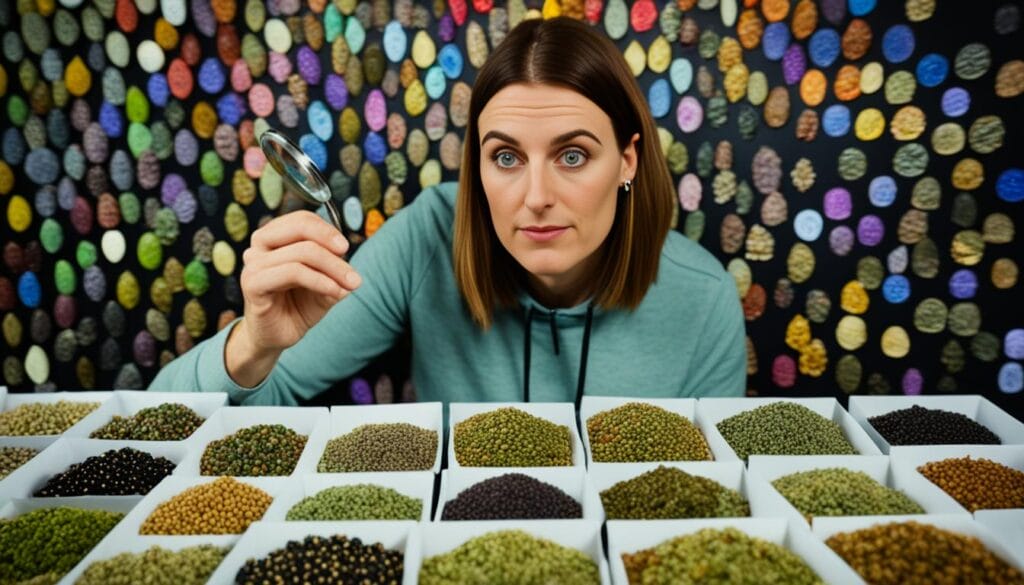
Understanding Your Goals and Planting Accordingly
Gazing into the world of cannabis seeds, we uncover a tapestry of options, each tailored for different goals. Are you looking at therapeutic outcomes, seeking particular sensory experiences, or focusing on ease of cultivation?
- Medicinal growers might prioritize high-CBD strains that provide relief without intense psychoactive effects
- Connoisseurs may seek out specific terpene profiles for a particular aroma or flavor
- Beginners often benefit from autoflowering seeds, which are less labor-intensive and easier to manage
Each seed type—be it regular, feminized, or autoflowering—comes with intrinsic growing requirements and plays a role in the realization of your cultivation narrative.
Considering Climate and Environment for Seed Selection
Another essential factor in seed selection is the environment where your cannabis will flourish. Choosing seeds that are compatible with your local climate, attributes of your growing space, and your capacity to manage the needs of the plants is critical. Outdoor growers must consider the natural light cycles, temperature range, and humidity, while indoor growers have more control over these environmental variables.
| Seed Type | Climate/Environment Suitability | Yield Potential | Photoperiod Sensitivity |
|---|---|---|---|
| Regular | Moderate, Controlled | High | High |
| Feminized | Varied, Adaptable | High (Female plants only) | High |
| Autoflower | Short summers, Inconsistent light | Lower | Low (Not light-dependent) |
When it comes to climate and the overall environment, autoflowering seeds are often championed for their resilience and adaptability. In contrast, photoperiod-sensitive strains like regular and feminized seeds will require more vigilance and modification to thrive. Knowledge is power, and with the right insights into the different types of cannabis seeds, your garden is primed to yield its very best.
Key Steps in Germinating Cannabis Seeds Successfully
Embarking on the journey of germinating cannabis seeds can seem daunting, but with the right preparation and attention to detail, sprouting successful seedlings is achievable. Whether you are experimenting with various cannabis seed types or looking to streamline your process with efficient preparation techniques, the initial stage of germination is critical. Let’s explore the fundamental practices that lead to vigorous seed sprouting and the lush growth of sprouting cannabis seeds.
Preparation and Techniques for Seed Sprouting
Before you begin the germination process, it’s important to assemble all the necessary supplies and create the ideal environment for your cannabis seeds to thrive. Here are few essential preparation steps:
- Select a proper germination medium like peat pellets or a simple arrangement of moist paper towels
- Ensure environmental controls are in place to maintain a steady temperature of around 70 to 85 degrees Fahrenheit (20-30°C) and consistent moisture
- Practice cleanliness to prevent contamination and protect emerging radicles (seed roots) from harmful pathogens
These steps will set the foundation for a successful germination period, paving the way for robust plant development.
Common Mistakes to Avoid During Germination
The germination phase is delicate, and certain missteps can inhibit the growth potential of your cannabis seeds. Be on the lookout for these common pitfalls:
- Overwatering: While moisture is crucial, too much can drown your seeds or lead to fungal diseases.
- Excessive handling: Seeds are sensitive. Handle them minimally and with care to avoid damage.
- Impatience: Don’t rush the process. Transplant seedlings only when they are sturdy enough to withstand the move.
Avoiding these mistakes will augment your chances of cultivating a healthy cannabis plant that can fulfill its genetic potential. The attention you give during these early stages will be evident in the quality and vitality of your mature plants.
The Impact of Terpenes and Cannabinoids in Cannabis Plants
Cannabis has captivated enthusiasts not just for its psychoactive properties but for its complex chemistry that contributes to its diverse sensory experiences and its therapeutic potential. At the forefront of this complexity are terpenes and cannabinoids, distinct yet synergistic compounds that define a cannabis strain’s unique blueprint.
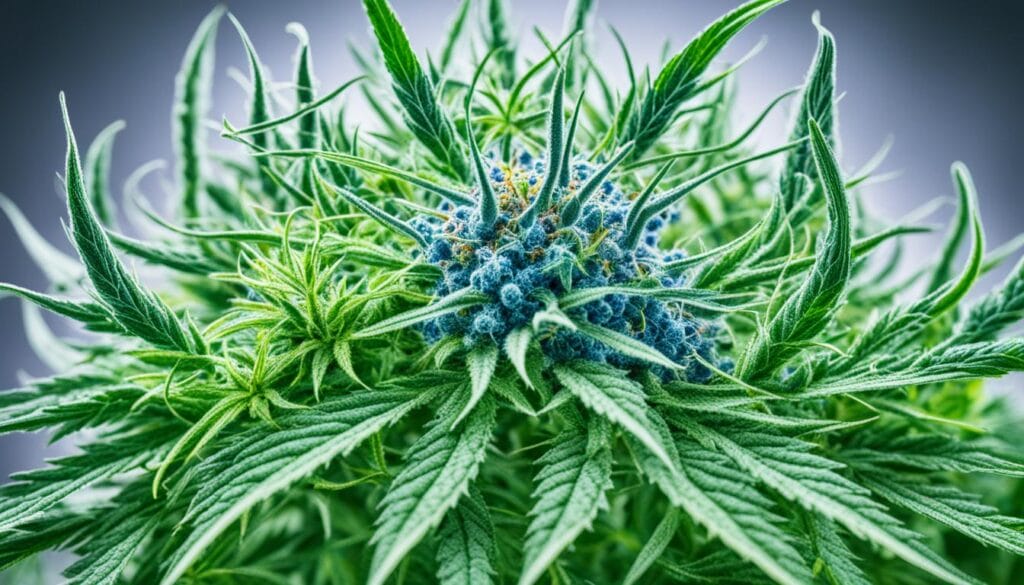
The Role of Terpenes in Flavor and Aroma Profiles
Terpenes are aromatic compounds found in the oils of all plants, including cannabis, and they impart distinctive flavors and aromas that can range from earthy and woody to citrusy and fruity. But terpenes contribute more than just appealing scents; they also influence how cannabinoids interact with the body, a phenomenon known as the “entourage effect.” Understanding the terpene profile is critical for both connoisseurs seeking a particular aroma and patients needing specific therapeutic outcomes.
- Myrcene: Herbal and earthy, associated with relaxing effects.
- Limonene: Citrusy and bright, often linked with mood elevation.
- Pinene: Piney and fresh, found to promote alertness and memory retention.
- Linalool: Floral and spicy, known for its stress-relieving properties.
- Caryophyllene: Peppery and spicy, binds to cannabinoid receptors to reduce inflammation.
Exploring the Medical Benefits of Cannabinoids
Cannabinoids such as THC and CBD are perhaps the most recognized compounds in cannabis, renowned for their mind-altering and medicinal capacities. THC, responsible for the plant’s intoxicating effects, also has medical applications, such as alleviating nausea and stimulating appetite. CBD, on the other hand, has gained attention for its ability to assuage a multitude of conditions without causing psychoactive effects—making it particularly appealing to those who seek the medical benefits of cannabinoids without the high.
| Cannabinoid | Medical Benefit |
|---|---|
| THC (Tetrahydrocannabinol) | Pain relief, nausea control, appetite stimulation |
| CBD (Cannabidiol) | Anxiety relief, anti-inflammatory, seizure suppression |
| CBN (Cannabinol) | Sleep aid, anti-bacterial, neuroprotectant |
| CBG (Cannabigerol) | Eye pressure reduction, anti-inflammatory, anti-fungal |
The symbiosis of terpenes and cannabinoids in generating the flavor profiles and the myriad medical benefits of cannabinoids underscore the holistic nature of cannabis. As research progresses, understanding the nexus of these compounds becomes increasingly significant, paving the way for innovative applications in both recreational enjoyment and medicinal treatment.
Regular vs Feminized vs Autoflower Seeds: Growing Cycles
With the diversity of cannabis seed options available to growers, understanding the unique growth cycles of regular seeds, feminized seeds, and autoflower seeds is vital for successful cultivation. Each seed type corresponds to specific photoperiod and development patterns, influencing not only the operational techniques but also the timing of the entire growth process.
Understanding Photoperiod and Growth Patterns
The concept of photoperiod plays a critical role in the development of regular and feminized cannabis plants. These types rely on specific light schedules to transition from vegetative growth to flowering. Regular seeds, while beloved for their genetic purity, require close attention to light management for initiating the flowering phase. Feminized seeds, popular for their guaranteed female plants, also depend on photoperiod changes but without the hassle of identifying and separating male plants.
Autoflower seeds break the mold by entering their flowering stage due to age rather than light exposure. Their independent nature simplifies the cultivator’s schedule, as these plants can flower under nearly any light conditions, offering a quick and resilient crop rotation.
Strategic Cultivation Techniques for Different Seed Types
Cultivators must tailor their approach to the chosen type of seed to maximize yield and potency. For regular seeds, growers often employ light deprivation or supplement techniques to trigger flowering at the desired time. Feminized seeds enable a more streamlined approach, focusing on canopy management and even light distribution to ensure uniform bud development.
Autoflower seeds are a boon for those seeking a more hands-off or rapid cultivation cycle. They’re well-suited for both indoor and outdoor environments, thriving with basic care that allows multiple harvests in a single season. Below, we explore the distinctive cultivation techniques associated with each seed type:
- Regular Seeds: Seasonal light adjustment, sex identification, and selective breeding possibilities.
- Feminized Seeds: Optimized space usage, no need for sexing, and consistent yields.
- Autoflower Seeds: Simplified cultivation, tolerance to varying light conditions, and multiple annual cycles.
| Seed Type | Photoperiod Dependency | Grower Intervention | Expected Yield Timing |
|---|---|---|---|
| Regular | Yes | High | Based on light cycle control |
| Feminized | Yes | Moderate | Based on light cycle control |
| Autoflower | No | Low | Predetermined growth period |
The choice between regular, feminized, and autoflower seeds shapes not only the immediate care each plant will require but also defines the overarching cultivation strategy. Whether it’s a seasoned grower or a novice starting their first batch, the knowledge of growth cycles and cultivation techniques for each seed type is indispensable for a bountiful and quality harvest.
Cannabis Seed Legality and Ethical Considerations in Cultivation
Cannabis seed legality remains a contentious and nuanced topic across the globe, deeply intertwined with ethical considerations that challenge the growers and the industry at large. This section explores how the intricate legal frameworks and ethical cultivation practices shape cannabis cultivation strategies and impact the industry’s dynamics.
In the United States, cannabis seed legality varies by state, reflecting a mosaic of policies that govern possession, sale, and cultivation. While some states embrace the cultivation of cannabis for medicinal and recreational use, others enforce stringent restrictions, leaving cultivators to navigate a labyrinth of regulations.
Amid legal constraints, an increasing number of growers are aligning their cultivation methods with principles of ethical cultivation. This involves employing sustainable farming techniques that respect the environment and promote biodiversity. Ethical cultivation practices include the use of organic methods, responsible water management, and the conscientious selection of pest control measures that are safe for beneficial insects and the surrounding ecosystem.
- Organic soil compositions that avoid synthetic fertilizers
- Integrated pest management systems to minimize chemical use
- Water conservation practices to support sustainability
- Energy-efficient lighting and climate control in indoor grows
The responsibility also extends to genetic conservation, where maintaining a diverse gene pool is recognized for its importance in preserving plant resilience and therapeutic properties. The ethical stewardship of cannabis genetics involves protecting rare strains from extinction and sharing knowledge within the cultivation community to nurture plant diversity.
Integrating cannabis cultivation strategies with ethical standards and legal requirements is not just about compliance, but about contributing to a transparent and responsible industry that acknowledges the value of the plant, the well-being of consumers, and the health of our planet.
How Seed Categories Influence Cannabis Cultivation Strategies
Choosing the right seed categories of cannabis is a pivotal step for any cultivator looking to optimize their growth operation. Whether you’re engaged in indoor cultivation or outdoor cultivation, each seed type brings its own set of advantages and challenges. Making informed decisions at this stage can have a profound impact on the final yield and potency of your cannabis plants. Here, we discuss the interaction between seed choice and cultivation methodologies, and we introduce advanced cultivation techniques aimed at optimizing plant performance.
Indoor vs Outdoor Cultivation Based on Seed Types
Indoor growers often prefer feminized seeds for their efficient use of space and predictable flowering periods. With controlled environments and the ability to manage lighting schedules, these growers can leverage advanced techniques to influence robust plant growth.
Contrastingly, outdoor cultivation harnesses the power of natural elements. Regular seeds are celebrated for their genetic diversity and vigor, key to thriving in dynamic environmental conditions. Autoflower seeds are particularly beneficial for outdoor growers, as they enable multiple harvest cycles within the same season due to their unique ability to flower automatically without depending on light schedules.
Advanced Techniques for Optimizing Yield and Potency
With the goal of optimizing yield and potency, advanced cultivation techniques are vital. Here’s an encapsulation of some cutting-edge strategies tailored to different seed categories:
- Screen of Green (ScrOG): A technique designed to maximize light exposure and space, particularly useful for indoor growers of feminized and autoflowering seeds.
- Supercropping: This method involves carefully stressing plants to encourage stronger stem growth, applicable to robust strains derived from regular seeds.
- Living soils: Utilizing organic, nutrient-rich soils that foster a microecosystem can push both yield and potency to higher levels, suitable for any seed category.
As the cannabis industry evolves, so do the techniques for raising these plants. Understanding the synergy between seed types and cultivation strategies is key for anyone looking to master the art of cannabis growth and produce quality, high-yielding crops.
Conclusion
As we navigate through the dynamic landscape of cannabis cultivation, a deep understanding of the different cannabis seed categories is not just a convenience—it’s a necessity. Regular, feminized, and autoflower seeds each unveil a unique lexicon of cultivation intricacies, rewarding growers with a wealth of possibilities tailored to their cultivation environment and personal preferences. The implications of choosing the best cannabis seed categories extend beyond mere agricultural concerns, intertwining with the broader cultural and consumer trends that propel the cannabis industry forward.
Summarizing the Importance of Understanding Cannabis Seed Categories
Whether you’re an aspiring cultivator or a seasoned enthusiast, recognizing the distinct potential and requirements of various seed types magnifies the prospects of a successful harvest. From the meticulous nature of regular seeds catering to breeders, to the streamlined approach offered by autoflower varieties, each category plays a pivotal role in fulfilling both recreational and medicinal aspirations. It’s undeniable that the proficiency in this domain anchors the entire cultivation process, right from germination to the flowering grandeur.
Future Outlook: The Evolution of Cannabis Seed Genetics and Market Trends
Peering into the future of cannabis genetics, we stand on the verge of discovering more refined and specialized strains. As geneticists and breeders pursue innovation, we anticipate the advent of seeds that not only optimize for medical outcomes but also accommodate the ebb and flow of grower approaches and market demands. This evolution is set against a backdrop of burgeoning market trends that herald an era of diversity and sophistication in cannabis products. Thus, staying attuned to the progress in cannabis seed genetics becomes quintessential for those striving to make informed decisions in a market rich with potential and steeped in continuous transformation.
Now that you understand the differences among cannabis seed categories, shop the wide selection of regular, feminized, and autoflower seeds at Seeds Here Now.
FAQ
What are the main seed categories of cannabis?
The main seed categories of cannabis include regular seeds, feminized seeds, and autoflower seeds. Each category has distinct cultivation requirements and is suited to different growers’ needs.
What are regular cannabis seeds?
Regular cannabis seeds are natural seeds that have not been genetically manipulated. They yield both male and female plants, which is essential for breeding and genetic diversity but require sex identification to eliminate males for bud production.
What are feminized cannabis seeds and their benefits?
Feminized cannabis seeds are genetically engineered so that they only produce female plants. This eliminates the chance of male plants and ensures that nearly 100% of plants from feminized seeds will be bud-producing females, making them popular among growers focused on yield efficiency.
How do autoflower cannabis seeds differ from regular and feminized seeds?
Autoflower cannabis seeds are bred to flower automatically after a certain period of growth, regardless of the light cycle, due to their Cannabis Ruderalis genetics. This makes them ideal for beginners or those looking for a quick turn-around, as they are easier to cultivate and can allow for multiple harvests in one season.
Can you explain the difference between Indica and Sativa cannabis seeds?
Indica seeds generally produce plants that are shorter with denser buds and are known for their relaxing effects, while Sativa seeds produce taller plants with more spread-out buds and are associated with a more energizing experience. However, these are broad generalizations, and the effects can vary widely within each species.
What are the pros and cons of autoflower versus regular cannabis seeds?
Autoflower seeds are straightforward to grow and not dependent on light cycles, making them suitable for rapid and multiple harvests. Regular seeds allow for more control over the growing process and are better for breeding purposes, but they require sex identification and proper lighting schedules for flowering.
How to choose the best cannabis seed bank when purchasing seeds online?
Look for seed banks with a strong reputation for quality and customer service. Factors to consider include germination guarantees, customer reviews, strain selection, discreet shipping, and secure payment options. Seed banks like SeedsHereNow.com are well-regarded in the cannabis community.
What are the key considerations for selecting the right cannabis seeds for growing?
Important considerations include your cultivation goals, whether you prefer Indica or Sativa effects, climate and grow environment, plant size, yield potential, and whether you want to grow from clones or seeds. It’s essential to choose seeds that align with your needs and preferences.
What are some common mistakes to avoid during the germination of cannabis seeds?
Avoid overwatering the seeds, which can lead to mold or rot, and ensure they are kept in a warm environment with proper moisture. Do not handle the seeds excessively, and be gentle when transplanting sprouted seeds to avoid damaging the delicate roots.
How do the terpenes and cannabinoids in cannabis plants affect the user experience?
Terpenes contribute to the flavor and aroma of cannabis, and can also influence the therapeutic effects of the strain. Cannabinoids such as THC and CBD are responsible for the plant’s psychoactive and medicinal properties, affecting how cannabis may relieve symptoms or provide a desired experience.
Are there ethical considerations in cannabis cultivation?
Yes, ethical considerations include sustainable farming practices, avoiding the use of harmful pesticides, preserving genetic diversity, and ensuring responsible management of plant genetics. Growers should also comply with local laws and regulations regarding cannabis cultivation.
How do different cannabis seed types influence indoor versus outdoor cultivation strategies?
Seed types can greatly influence cultivation strategies. Indoor growers might prefer feminized seeds for their predictable output and space efficiency, while outdoor growers may choose autoflower seeds for multiple harvests or regular seeds for their robust genetics. The choice of seeds should align with the grower’s method and goals for cultivation.
Suggested Articles
;)
;)
;)



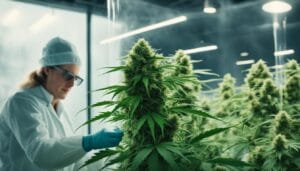
 18 Jun 2025
18 Jun 2025  25 min read
25 min read

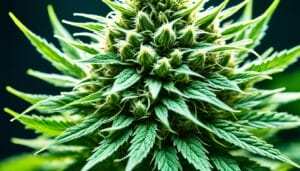
 February 20, 2024
February 20, 2024 


RESPONSES (0)
No responses yet. Be the first to respond!